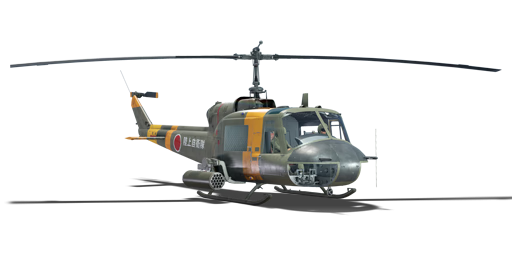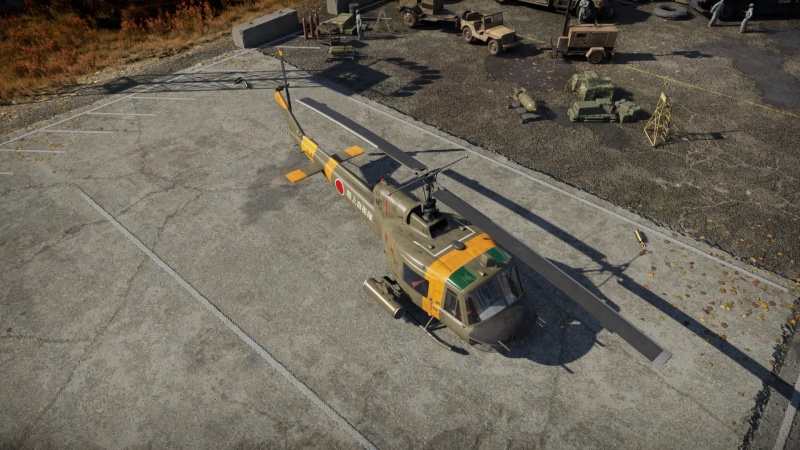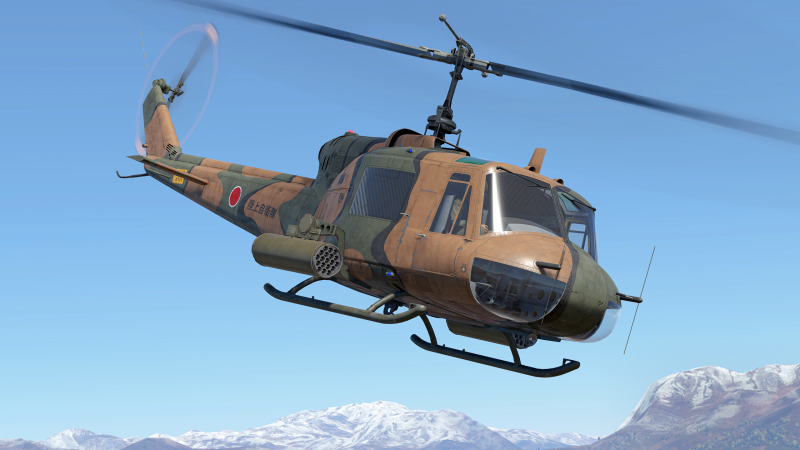Difference between revisions of "UH-1B (Japan)"
(→History: https://forum.warthunder.com/index.php?/topic/438464-fuji-uh-1b-hiyodori/) |
Colok76286 (talk | contribs) (Edits) |
||
| Line 88: | Line 88: | ||
== History == | == History == | ||
<!-- ''Describe the history of the creation and combat usage of the helicopter in more detail than in the introduction. If the historical reference turns out to be too long, take it to a separate article, taking a link to the article about the vehicle and adding a block "/History" (example: <nowiki>https://wiki.warthunder.com/(Vehicle-name)/History</nowiki>) and add a link to it here using the <code>main</code> template. Be sure to reference text and sources by using <code><nowiki><ref></ref></nowiki></code>, as well as adding them at the end of the article with <code><nowiki><references /></nowiki></code>. This section may also include the vehicle's dev blog entry (if applicable) and the in-game encyclopedia description (under <code><nowiki>=== In-game description ===</nowiki></code>, also if applicable).'' --> | <!-- ''Describe the history of the creation and combat usage of the helicopter in more detail than in the introduction. If the historical reference turns out to be too long, take it to a separate article, taking a link to the article about the vehicle and adding a block "/History" (example: <nowiki>https://wiki.warthunder.com/(Vehicle-name)/History</nowiki>) and add a link to it here using the <code>main</code> template. Be sure to reference text and sources by using <code><nowiki><ref></ref></nowiki></code>, as well as adding them at the end of the article with <code><nowiki><references /></nowiki></code>. This section may also include the vehicle's dev blog entry (if applicable) and the in-game encyclopedia description (under <code><nowiki>=== In-game description ===</nowiki></code>, also if applicable).'' --> | ||
| − | The JGSDF quickly realized the potential of combat | + | The JGSDF quickly realized the potential of combat manoeuvres between helicopters and ground forces, to be able to supply, and provide fire support quickly and effectively while also transporting infantry into battle. In 1959, the Bell UH-1 entered service with the US Army, this vehicle proved to fit the needs of a true medium sized general purpose helicopter to replace their aging H-19Cs. Fuji would soon be able to obtain the license to the UH-1B, originally receiving the designation HU-1B. With manufacturing in Japan approved, the production of the UH-1B started immediately. Officially, the helicopter received from the JGSDF the formal name of "Hiyodori" or Bulbul in English, after a type of medium sized songbird. Production commenced in 1962 and ran until 1972 for a total of 90 UH-1Bs produced. The Fuji UH-1B was a exact copy of the Bell UH-1B and was powered by the licensed produced Kawasaki T53-K-5 producing 960 SHP. As weapon trials of the H-13H began with various armament, it was realized a larger more powerful helicopter was needed for a more practical air support role. By 1967 plans were underway to fit the UH-1B with 70 mm unguided rockets, and in 1978 UH-1Bs were spotted at the "Total thermal power" exercise in Japan carrying rocket pods. The UH-1B would later be complemented by the much improved UH-1H, and later replaced by the UH-1J. However, neither the UH-1H or UH-1J have been armed or are planned to be armed with offensive weapon capabilities. The UH-1B would officially be retired in 1992, marking a quarter of a century's worth of service. |
== Media == | == Media == | ||
Revision as of 08:11, 25 September 2022
| This page is about the utility helicopter UH-1B (Japan). For other versions, see UH-1 (Family). |
Contents
Description
The ▅UH-1B Hiyodori is a rank V Japanese utility helicopter with a battle rating of 8.3 (AB), 7.7 (RB), and 8.0 (SB). It was introduced in Update "Starfighters".
As a license-built UH-1B by Fuji Heavy Industries it only differs in armament and name, with a Japanese-produced engine that delivers the same amount of power. It's officially designated by the JGSDF as UH-1B Hiyodori (ひよどり, Bulbul).
General info
Flight performance
Providing decent manoeuvrability and speeds the Hiyodori can deliver its few rockets to the battle as soon as possible and evading gunfire when used to its advantage. Though flying straight into combat isn't always as advantageous so attempt to use the speed and manoeuvrability the UH-1 offers to fly off-course in a flanking route and low behind cover before unleashing 38 FFARs at the enemies backs and get away again.
| Characteristics | Max Speed (km/h at 0 m - at sea level) |
Max altitude (metres) | |
|---|---|---|---|
| AB | RB | ||
| Stock | 203 | 196 | 5900 |
| Upgraded | 230 | 217 | |
Survivability and armour
Helicopters have a unique role on the battlefield and fitting them with armour is not as easy as it is on a tank or on a jet. The helicopter's setup is such that it must take off and land vertically, hover and fly and as the aircraft gets heavier, bigger and heavier equipment are needed to balance until you are left with a massive helicopter which cannot fly or do its intended mission. The Huey balances this out with a vehicle which can manoeuvre as needed and carry a decent payload whether people or weapon systems.
The UH-1B does not fly with any protective armour or bullet-proof glass, which if installed would decrease the UH-1's ability to complete its mission. As such, the pilot must take this into account and fly the helicopter accordingly. Bull rushing right into the middle of a battlefield usually ends with disastrous results as the without armour, the Huey has nothing but thin metal fuselage coverings to protect the crew and vital equipment. The engine, transmission, main rotor and tail rotors are all exposed to fire from missiles, rockets, cannons and even small calibre machine guns. The pilot must be aware of their surrounds and work to fight from the enemy vehicles blind spots or weak sides, because a burning and crashed helicopter only pads the enemies' score-count. Pick and choose your battles to preserve the helicopter.
But the "thin metal fuselage" is still "metal", it would provide minor, temporary protection for the interior modules (i.e. fuel, transmission, engine, crew, etc). This means that calibres that are 7.62 mm and below could potentially be stopped by the fuselage for a few several hundred shots until the fuselage starts giving warning when it slowly becomes yellow or orange.
Modifications and economy
The Hiyodori doesn't pack much armament and doesn't come with any armament upgrades, it's advised to work on flight performance while grinding your way up to getting the helicopter spaded and working towards the next vehicle, the AH-1S early.
Armaments
Suspended armament
The UH-1B (Japan) can be outfitted with the following ordnance:
- 38 x FFAR Mighty Mouse rockets
Usage in battles
The UH-1B Hiyodori offers very little in a combat role due to lacklustre armament and minimal armour considering it's a utility helicopter. The most efficient way of utilizing the Hiyodori is as follows:
- Ground Battles: Fly low and fast, utilize terrain as cover and unleash all of your rockets on the closest target while attempting to dodge MG fire
- Helicopter Battles: Avoid combat at all cost and unload your rockets into unprotected convoys, ground battles and/or bases
- Ground Assault battles
Here the Hiyodori can provide some support more than anywhere else. While still limited to the 38 FFARs, in AB you can single launch them and reload them mid-air, the best course of action is disabling tracks and/or engines on the approaching AI so that the ground forces can focus on the moving targets and create more time and room to work with. Assists almost give you as much as destroying the vehicles on your own so it's best to simply provide support to the team and not get too kill hungry on your own.
Pros and cons
Pros:
- Good manoeuvrability
Cons:
- Only armament is 38 FFAR rockets
- Weapons are mounted on the side, so it lacks accuracy in a head-on
- No armour
History
The JGSDF quickly realized the potential of combat manoeuvres between helicopters and ground forces, to be able to supply, and provide fire support quickly and effectively while also transporting infantry into battle. In 1959, the Bell UH-1 entered service with the US Army, this vehicle proved to fit the needs of a true medium sized general purpose helicopter to replace their aging H-19Cs. Fuji would soon be able to obtain the license to the UH-1B, originally receiving the designation HU-1B. With manufacturing in Japan approved, the production of the UH-1B started immediately. Officially, the helicopter received from the JGSDF the formal name of "Hiyodori" or Bulbul in English, after a type of medium sized songbird. Production commenced in 1962 and ran until 1972 for a total of 90 UH-1Bs produced. The Fuji UH-1B was a exact copy of the Bell UH-1B and was powered by the licensed produced Kawasaki T53-K-5 producing 960 SHP. As weapon trials of the H-13H began with various armament, it was realized a larger more powerful helicopter was needed for a more practical air support role. By 1967 plans were underway to fit the UH-1B with 70 mm unguided rockets, and in 1978 UH-1Bs were spotted at the "Total thermal power" exercise in Japan carrying rocket pods. The UH-1B would later be complemented by the much improved UH-1H, and later replaced by the UH-1J. However, neither the UH-1H or UH-1J have been armed or are planned to be armed with offensive weapon capabilities. The UH-1B would officially be retired in 1992, marking a quarter of a century's worth of service.
Media
- Skins
See also
External links
Paste links to sources and external resources, such as:
- topic on the official game forum;
- other literature.
| Fuji Heavy Industries, Ltd. (富士重工業株式会社) | |
|---|---|
| Utility | UH-1B Hiyodori* |
| Attack | ▅AH-1E* · AH-1S* · AH-1S Kisarazu* |
| AH-64DJP* | |
| *Licensed | |
| Fuji Heavy Industries traces its roots to the Nakajima Aircraft Company. At the end of World War II, Nakajima was broken up by the Allied Occupation government, and by 1957 part of the separated company was already known as Fuji Heavy Industries.
Fuji Heavy Industries was renamed to Subaru Corporation from 2017 onward. | |
| See also | Nakajima Aircraft Company (1918-1945) · Bell Aircraft Corporation · Boeing Aircraft |
| Japan helicopters | |
|---|---|
| Utility | ▅UH-1B |
| Attack | ▅AH-1E · AH-1S · AH-1S Kisarazu |
| AH-64DJP | |






